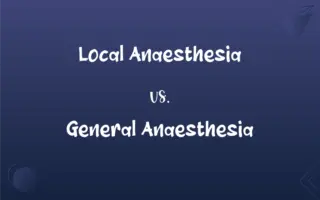Ionic Contrast Media vs. Nonionic Contrast Media: What's the Difference?
Edited by Aimie Carlson || By Janet White || Published on February 17, 2024
Ionic contrast media are radiographic dyes that dissociate into ions in solution, often causing more side effects, whereas nonionic contrast media do not dissociate and are generally safer with fewer side effects.

Key Differences
Ionic contrast media are compounds used in radiology that dissociate into charged particles (ions) when injected into the body. This dissociation can lead to higher osmolality, which often correlates with more side effects like discomfort or allergic reactions. On the other hand, nonionic contrast media consist of molecules that do not dissociate into ions in solution. Their lower osmolality tends to make them better tolerated, resulting in fewer side effects and a generally safer profile for patients.
The ionic nature of these contrast agents affects their interaction with body tissues. Ionic contrast media tend to be more reactive, which can cause increased sensations of heat or pain upon injection. Nonionic contrast media, being less reactive, typically result in a more comfortable experience for the patient, with less heat or pain sensation during the procedure.
In terms of safety profile, ionic contrast media have a higher incidence of allergic-like reactions compared to nonionic contrast media. The high osmolality of ionic contrast agents is responsible for this increased risk. Nonionic contrast media, due to their low osmolality, are associated with a significantly lower risk of allergic reactions and nephrotoxicity, making them preferable, especially in patients with pre-existing conditions like renal impairment or a history of allergic reactions.
The use of ionic contrast media is more common in situations where cost is a major concern, as they are generally less expensive than nonionic agents. However, the overall safety and comfort advantages of nonionic contrast media often outweigh their higher cost, particularly in more vulnerable patient populations.
In imaging quality, there is no significant difference between ionic and nonionic contrast media. Both types are effective in enhancing the visibility of internal structures in radiographic procedures. The choice between them is primarily based on the safety profile and patient tolerance rather than the imaging quality.
ADVERTISEMENT
Comparison Chart
Ionic Dissociation
Dissociates into ions in solution
Does not dissociate into ions
Osmolality
Higher osmolality
Lower osmolality
Side Effects
More side effects like discomfort and allergic reactions
Fewer side effects and generally safer
Cost
Generally less expensive
More expensive
Preferred Use
Used where cost is a constraint
Preferred in patients with allergies or renal impairment
ADVERTISEMENT
Ionic Contrast Media and Nonionic Contrast Media Definitions
Ionic Contrast Media
"Ionic contrast media are radiographic dyes that dissociate into charged particles in the body."
The use of ionic contrast media in the patient's X-ray resulted in a clear image but with some discomfort.
Nonionic Contrast Media
"These agents are preferred for their safer profile in vulnerable patients."
For the renal-impaired patient, nonionic contrast media were the safest option.
Ionic Contrast Media
"They are often associated with a higher incidence of adverse reactions."
Despite the risk of a reaction, ionic contrast media were used due to budget constraints.
Nonionic Contrast Media
"They have lower osmolality, reducing the risk of side effects."
Nonionic contrast media were chosen for the allergic patient to minimize reactions.
Ionic Contrast Media
"Ionic contrast media enhance radiographic images by altering X-ray absorption."
For the angiogram, ionic contrast media were selected due to their cost-effectiveness.
Nonionic Contrast Media
"Nonionic contrast media are radiographic dyes that do not dissociate into ions in the body."
The patient experienced less discomfort with the nonionic contrast media during the MRI.
Ionic Contrast Media
"These media are characterized by their ability to ionize in solution."
During the CT scan, ionic contrast media caused a warm sensation in the patient.
Nonionic Contrast Media
"Nonionic contrast media are more expensive but offer greater patient comfort."
Although costlier, nonionic contrast media were used for their reduced side effects.
Ionic Contrast Media
"They are high-osmolality agents used in medical imaging."
The ionic contrast media provided excellent vessel contrast but increased the risk of side effects.
Nonionic Contrast Media
"Nonionic media enhance medical images without ionizing in solution."
The nonionic contrast media provided clear imaging without causing heat sensation.
FAQs
Are nonionic contrast media safer for all patients?
Generally, yes, especially for those with allergies or kidney issues.
Why are ionic contrast media used less frequently now?
Due to their higher risk of side effects compared to nonionic media.
Can ionic contrast media cause allergic reactions?
Yes, they have a higher risk of causing allergic reactions.
Why are nonionic contrast media more expensive?
Their complex composition and lower side effect profile increase the cost.
Are there any patients who should avoid ionic contrast media?
Patients with a history of allergic reactions or kidney problems.
Can nonionic contrast media be used in renal failure patients?
They are safer, but caution is still advised in renal failure.
Do nonionic contrast media completely eliminate the risk of side effects?
No, but they significantly reduce the risk.
What are ionic contrast media?
Ionic contrast media are radiographic dyes that ionize in body fluids.
Is the warm sensation more common with ionic or nonionic media?
More common with ionic media due to higher osmolality.
How do nonionic contrast media differ from ionic ones?
Nonionic media do not ionize and have lower osmolality, reducing side effects.
Do ionic contrast media provide clearer images than nonionic?
No, both provide similar imaging quality.
Can both types of contrast media be used in CT scans and MRIs?
Yes, but the choice depends on the patient's condition and the imaging needs.
Are there any dietary restrictions before using nonionic contrast media?
Generally no, but follow specific instructions from the healthcare provider.
Is there a preference for nonionic media in pediatric imaging?
Yes, due to the lower risk of adverse reactions.
Are ionic contrast media still used in modern medical imaging?
Yes, but less frequently and in specific circumstances.
Is premedication necessary for nonionic contrast media?
Not usually, but it depends on the patient's allergy history.
Can both types of contrast media affect kidney function?
Yes, but nonionic media are less likely to cause nephrotoxicity.
Why might a healthcare provider choose ionic contrast media?
Often due to cost considerations or specific imaging requirements.
How do patients typically react to ionic contrast media?
They may experience more heat, pain, or side effects.
What are the primary uses of ionic contrast media today?
They are used where cost is a major concern or in less sensitive imaging.
About Author
Written by
Janet WhiteJanet White has been an esteemed writer and blogger for Difference Wiki. Holding a Master's degree in Science and Medical Journalism from the prestigious Boston University, she has consistently demonstrated her expertise and passion for her field. When she's not immersed in her work, Janet relishes her time exercising, delving into a good book, and cherishing moments with friends and family.
Edited by
Aimie CarlsonAimie Carlson, holding a master's degree in English literature, is a fervent English language enthusiast. She lends her writing talents to Difference Wiki, a prominent website that specializes in comparisons, offering readers insightful analyses that both captivate and inform.






































































